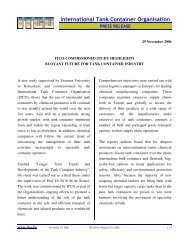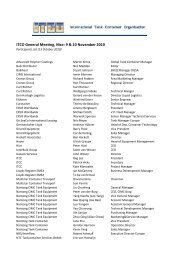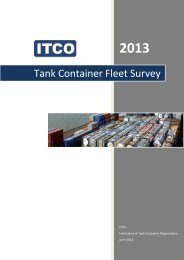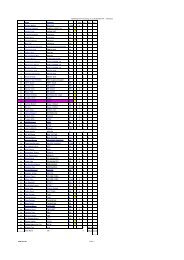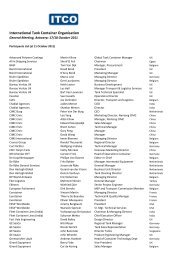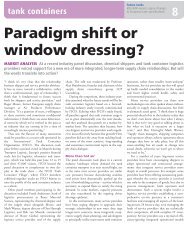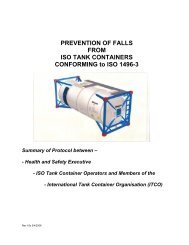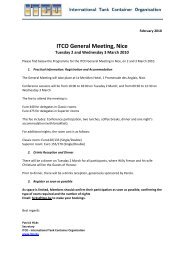You also want an ePaper? Increase the reach of your titles
YUMPU automatically turns print PDFs into web optimized ePapers that Google loves.
ICHCA International <strong>Safe</strong>ty Panel Briefing Pamphlet No 30<br />
6 <strong>Tank</strong> Container <strong>Safe</strong>ty<br />
6.1 General<br />
6.1.1 ISO tank containers built to ISO 1496 / 3 and swap tanks built to CEN 1432<br />
and complying fully with the IMDG Code are inherently safe - there have<br />
been very few recorded examples where the pressure vessel has been<br />
damaged sufficiently to permit a serious leak.<br />
6.1.2 <strong>Tank</strong> containers shall not be <strong>of</strong>fered for transport:<br />
if containing liquids having a viscosity less than 2,680 mm 2 /s at 20 ° C<br />
or at the maximum temperature <strong>of</strong> the substance during transport in<br />
the case <strong>of</strong> a heated substance, with a degree <strong>of</strong> filling <strong>of</strong> more than<br />
20% but less than 80% unless the shells <strong>of</strong> portable tanks are divided<br />
into sections <strong>of</strong> not more than 7,500 litre capacity by partitions or<br />
surge plates; (see also Annex 2 section A2.2.<br />
with residue <strong>of</strong> substances previously transported adhering to the<br />
outside <strong>of</strong> the shell or service equipment;<br />
when leaking or damaged to such an extent that the integrity <strong>of</strong> the<br />
portable tank or its lifting or securing arrangements may be affected;<br />
and<br />
unless the service equipment has been examined and found to be in<br />
good working order. For certain dangerous substances, a lower<br />
degree <strong>of</strong> filling may be required.<br />
6.1.3 <strong>Tank</strong> containers shall not be filled or discharged while they remain on board<br />
a ship.<br />
6.2 Design<br />
6.2.1 Swap tanks may have thinner wall thickness than is required for the<br />
transport <strong>of</strong> dangerous goods by sea. Shipping lines may be approached to<br />
ship laden new swap tanks from non-European ports. So long as the cargo<br />
carried is classified as non-regulated or the shell wall thickness complies<br />
with the IMDG Code requirements then the swap tank may be shipped. See<br />
also sections 6.1.2 and 12.3.<br />
6.2.2 Designers <strong>of</strong> tank containers and legislators concerned with the carriage <strong>of</strong><br />
hazardous substances recognise that there is a need for fail safe features<br />
built into any opening in the pressure vessel. These features are described<br />
below:<br />
6.2.3 Manways<br />
6.2.3.1 The number <strong>of</strong> swing bolts or flange bolts varies from type to type and the<br />
pressure rating <strong>of</strong> the tank. However, when they are fully tightened they<br />
must form a pressure tight seal that is at least as high as the test pressure <strong>of</strong><br />
the tank<br />
Note: Failure to tighten the swing or flange bolts correctly can result in the<br />
cargo leaking if the tank container is overturned.<br />
6.2.3.2 The manway is protected from swipe damage by the spill box where one is<br />
fitted.<br />
Page 23 ©ICHCA International Limited



